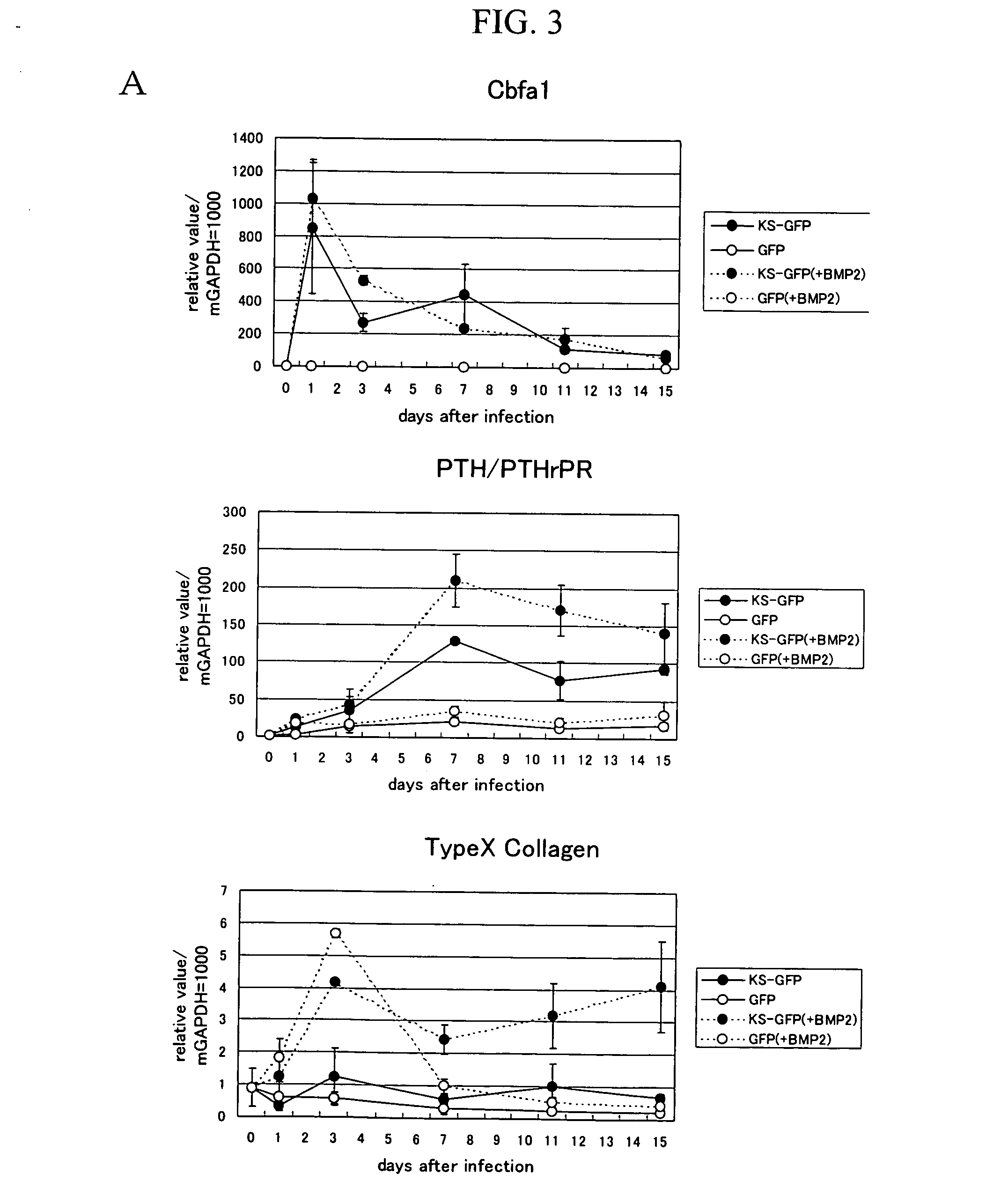Bone and/or joint disease-associated genes
a technology of gene and bone, applied in the field of bone and/or joint disease-associated genes, can solve the problems of difficult identification of genes, inability to identify genes by itself, and lack of medical devices having a mechanism that clearly inhibits cartilage degeneration and stimulates cartilage regeneration. to achieve the effect of stimulating cartilage differentiation and increasing or decreasing expression levels
- Summary
- Abstract
- Description
- Claims
- Application Information
AI Technical Summary
Benefits of technology
Problems solved by technology
Method used
Image
Examples
example 1
Isolation of Primary Chondrocyte from Runx2 / Cbfa1-Deficient Mouse Fetus and Establishment of Chondrocyte Cell Lines from Runx2 / Cbfa1- and p53-Deficient Murine Embryonic Skeleton
(1) Sampling of Primary Chondrocyte Derived from Runx2 / Cbfa1− / − Mouse
[0217] The Runx2 / Cbfa1 knockout mice prepared by Komori et al. were used (Cell, 1997, 89, 755-764, JP Patent Publication (Unexamined) No. 10-309148 (1998)). The skeletons were collected from the Runx2 / Cbfa1-homodeficient mice at day 18.5 of embryonic development, and the skeletons were treated with a solution containing 0.1% EDTA and 0.1% Trypsin (pH 7.4) at 37° C. for 60 minutes. Thereafter, the skeletons were treated with 1.5 mg / ml collagenase and alpha modified-minimum essential medium (αMEM) for 3.5 hours to obtain a cell suspension. The cell suspension was cultured on a collagen-coated dish containing Dulbecco's Modified Eagle's Medium / Ham's F12 (1:1) hybrid medium (Gibco BRL) containing 10% fetal bovine serum for 2 or 3 days for cel...
example 2
Construction of a System of Inducing Cartilage Differentiation via Forced Expression of Runx2 / Cbfa1 Using an Adenovirus
(1) Construction of an Adenovirus for the Expression of Runx2 / Cbfa1
[0221] cDNA comprising the open reading frame (ORF) of murine Runx2 / Cbfa1 was inserted into the BarnHI site of pIRES2-EGFP (Biosciences Clontech), and a fragment containing Runx2 / Cbfa1, the internal ribosome entry site (IRES), and the enhanced green fluorescence protein (EGFP) was inserted into the BamHI-XbaI site of the shuttle vector pACCMV.pLpA (Proc. NatI. Acad. Sci. U.S.A., 1993, 90, 2812-2816). The constructed vector was cotransfected into the human kidney cell line 293 with the adenovirus vector pJMI7 (Virology, 1988, 163, 614-617) using the Superfect transfection reagent (Qiagen). The adenovirus retaining a Runx2 / Cbfa1 fragment resulting via homologous recombination was subjected to subculture 3 or 4 times with the use of the cell line 293 to multiply the viruses. A roughly purified stock ...
example 3
Isolation of Downstream Gene of Runx2 / Cbfa1 via Subtraction
[0228] The downstream gene of Runx2 / Cbfa1 was obtained via subtraction using the undifferentiated mesenchymal cell line (C3H10T1 / 2). At the outset, the C3H10T1 / 2 cell line that intensively expresses Runx2 / Cbfa1 was established (C3H10T1 / 2-Runx2 / Cbfa1). Subsequently, C3H10T1 / 2-Runx2 / Cbfa1 and C3H10T1 / 2 were used to screen for the gene that is intensively expressed in the C3H10T1 / 2-Runx2 / Cbfa1 cell line via subtraction. Subtraction was carried out using the CLONTECH PCR-Select™ cDNA Subtraction Kit in accordance with the user's manual. As a result, the expression level of the gene shown in SEQ ID NO: 11 (Riken cDNA 2810002E22 gene (HNOEL-iso homolog)) was found to be higher in C3H10T1 / 2-Runx2 / Cbfa1 than in C3H10T1 / 2.
[0229] Whether or not the HNOEL-iso homolog gene is induced by Runx2 / Cbfa1 was analyzed via real-time PCR in RU-1, RU-22, and Runx2 / Cbfa1− / −mouse-derived primary cultured chondrocytes, in order to confirm that the...
PUM
 Login to View More
Login to View More Abstract
Description
Claims
Application Information
 Login to View More
Login to View More - R&D
- Intellectual Property
- Life Sciences
- Materials
- Tech Scout
- Unparalleled Data Quality
- Higher Quality Content
- 60% Fewer Hallucinations
Browse by: Latest US Patents, China's latest patents, Technical Efficacy Thesaurus, Application Domain, Technology Topic, Popular Technical Reports.
© 2025 PatSnap. All rights reserved.Legal|Privacy policy|Modern Slavery Act Transparency Statement|Sitemap|About US| Contact US: help@patsnap.com



